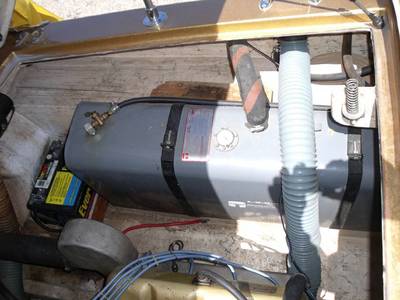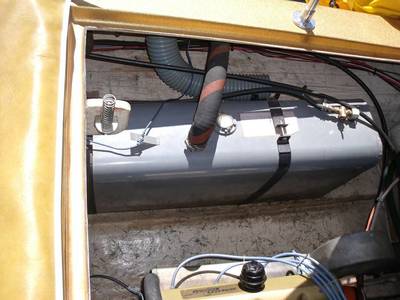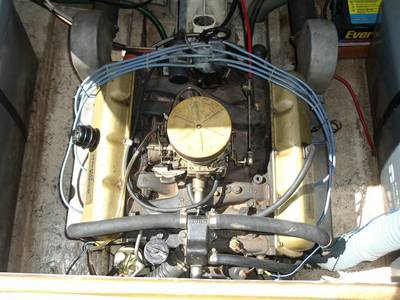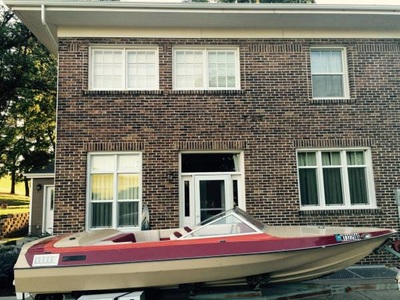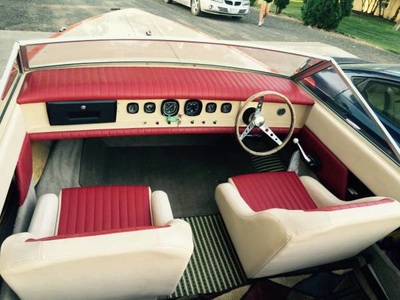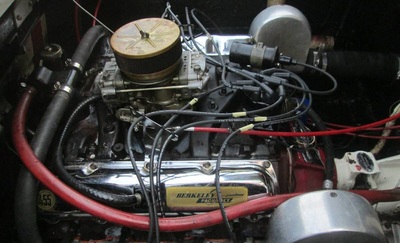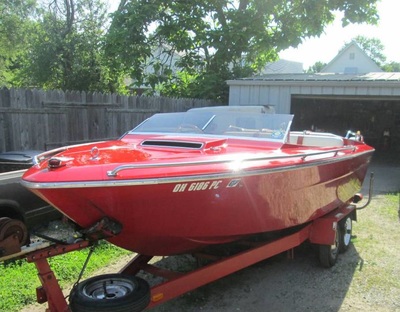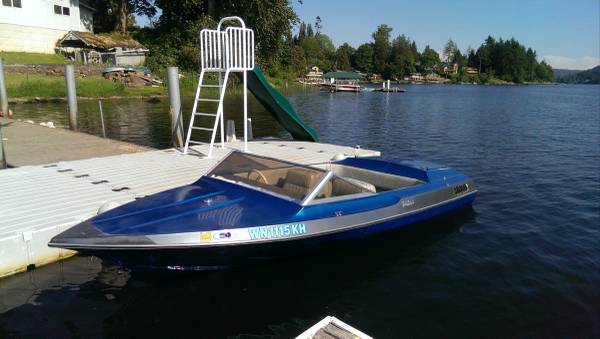|
According to the original manufacturer's description of the CV-21 in its initial year on the market, this was the "...first Glastron/Carlson to be designed and engineered for jet power alone." The "rich metalflake Gold and Sand" exterior was matched with a sportwheel, lockable glove compartment, plated grab bar, and teak trim and entry steps. Like many other Glastrons from this era, it also came with "superb instrumentation" so you'd know just how fast you were going and to keep tabs on the V8 performance. The propulsion for the CV-21 came from a Berkeley jet drive likely mated to a 455 Oldsmobile.
The pictures on this boat show an interesting fuel storage setup with large steel tanks in the engine compartment. Most boats with closed bow configurations utilize the dead space up front for the gasoline for both space savings and counterbalancing purposes. Given the fuel sucking potential of the V8 at wide open throttle it was probably a good idea to make sure both tanks were full at the beginning of any voyage. Another interesting difference between this boat and the original CV-21's is the windshield. On all of the 1971 through 1975 CV-21's we could not find any examples without the windshield supports went all the way back to the rear bench area. Rumor has it that these gaps were designed to allow the occupants to reach out and grab swimmers or docks as they approached.
6 Comments
The year of 1974 was a good one for the American Boat Company, especially when it comes to this particular American Eagle. The kinks from the first year of production were out of the way and the market was starting to fall in love with the model's design. While it has not been verified that the unique paint scheme on this boat was factory original, it does appear to fit the era of production. The cream, purple, and red color palette combined with the custom rear seating sets this boat apart from other American Eagles we've seen. Credit must be given to the quality of the interior workmanship as it matches the era and does not look out of place. While the original rear bench seats that came with the American Eagles were squared off in the corners, this custom interior takes cues from the Century Riviera 6-Meter rear seating minus the armrests.
The power plant in this beauty appears to be one of the 'Big Block' varieties that was commonly matched with the Berkeley Jet Drives. On top of the logical association between the jet drive and the common engines, the gold valve covers are a dead giveaway of an Oldsmobile engine. Not much is known about this Century Mark II besides that it is fast and loud. The most unique thing about this Retro Runabout is the rare Berkeley jet drive considering the make and model. Century was known for their direct drive applications at the time that this boat was produced and even with the complete switch to fiberglass in the 1980's the company predominantly stuck with sterndrive applications for their non-competition ski boats.
Like many of the Berkeley Packajet applications from the 1970's, this one came with a Oldsmobile 455. The 7.5L big block is sure to throw massive rooster-tails at full speed (50+ MPH). This 'Hot Rod' model shares some similarities to the Arabian such as the side-bench seating arrangement and upholstered rear deck. The bow deck appears to be an ode to its bigger brother with the hood-scoop-esque styling. If the Arabian was the bigger brother then the Ski Fury is definitely a close cousin. The direct drive from the Ski Fury compliments the Mark II's V-drive or jet setup in the same length hull. The bow deck styling and bottom-side transoms are also very similar. The CVX line from Glastron Carlson is the quintessential retro runabout. Coming in 16, 18, and 20 foot varieties, this boat is evidently built for speed and good looks. Like many of its contemporaries, this CVX-18 came stock with the gold-flake and plush interior. While it may look dated today, this interior was the cream of the crop when it arrived in the 1970's. The predecessor to the CVX-18 came out in 1972 when Glastron Carlson introduced the CV-16 outboard, CV-16SS sterndrive, CV-19 outboard, CV-19SS jet or sterndrive, and CV-21 jet models. These early CV's featured the classic Glastron C-shaped graphics and came in blue, gold, and green metal flake color schemes. By 1979 Glastron Carlson was in their 3rd year of producing the CVX-18 and offered it in two color choices, Champaign with Beige or Silver with Gray. The engine options were between a 898 Mercruiser or a 230 OMC. Both engines were based on the GM 305 V8. Many folks are surprised to learn that Chrysler was in the marine business for over 60 years. The division of the car manufacturer opened up shop in 1927 building inboards, jets, boats, and outboards up until 1993. The final Chrysler outboards were sold under the brand name Force which was subsequently acquired by Mercury Marine and eventually again by Brunswick soon after. This boat is a 20 foot runabout with a 360 cubic inch inboard paired with a jet, all built in-house by Chrysler. The unique styling features a sparkle blue interior and flared 'haunches' around the rear deck and engine compartment. While we do not have definitive dates of production, it appears that this model was produced up until 1979. The Jolly Roger is the original of the Spokane Retro Runabout manufacturers and features many of the tell-tale signs of 1960's and 1970's marine design. If the dashing gold flake paint jobs and screaming American Muscle didn't grab the attention of bystanders, it was definitely the stunning lines and speed. One of the defining characteristics of the Jolly Roger is the squared off transom. While the hull and deck are very similar to the Apollo and American Boat Company boats, the Jolly Roger has 90-degree corners in the stern. It is not known why this change was made by the other manufacturers while the rest of the styling was maintained. This particular boat likely came with a Mercruiser 4-cylinder based on the General Motors 3.0L/181 CID engine. The 140 motor was advertised as producing 140 horsepower with a fair amount of torque. This motor was matched with the 140 outdrive that also was used with the 120 and 470 motors. Nearing the end of the Apollo's boat building run, this 18' Starfire shows the company's commitment to building a good looking boat. The combination of the wood accents and metal flake paint make for a unique and eye catching vessel. This particular example came with a Mercruiser inboard outboard setup and likely the Ford 302 engine. The Ford 5.0L setup was known as the 888 and was marketed as producing 188 horsepower. The 888 outdrive was an early predecessor to the Alpha outdrives that are commonly used today. A beautiful 1977 American hit the market today in Spokane, WA. The boat comes with the OMC 235 V8 power plant paired with a Stringer outdrive. The OMC 235 is a Ford 351 Windsor that was advertised as producing 235 horsepower. This American is 18' in length and comes with a gold-flake brown strip down the sides. Based on other Americans that we have seen, the interior looks to be original and the dash and wooden steering wheel appear to be in great shape. Hit the link if you are interested: 1977 American Eagle in Spokane, WA For the first ever blog entry on Retro Runabout we will cover a classic 1980's Century, the Riviera 5-Meter. This boat is the smaller cousin of the Riviera 6-Meter that came with a Mercury 470 and Alpha 1 outdrive. They came in either red, navy blue, or purple and were built between 1981 and 1988 from what we have been able to determine. According to the 1983 brochure the 5-Meter is 16' 4.5" with a 27 gallon fuel tank. That tank paired with the 470 should give you a whole afternoon's worth of cruising around. The purple example we have here today hails from Wisconsin and looks like it needs a bit of interior TLC. |
Archives
December 2016
Categories
All
Follow us:
|
JOLLY ROGER | DONZI | GLASTRON CARLSON | APOLLO BOATS
AMERICAN BOAT COMPANY | CENTURY BOAT COMPANY
If you find inaccuracies or have anything to add please do not hesitate to contact us by clicking here.
Copyright Terranean Image, LLC © 2016
Copyright Terranean Image, LLC © 2016





